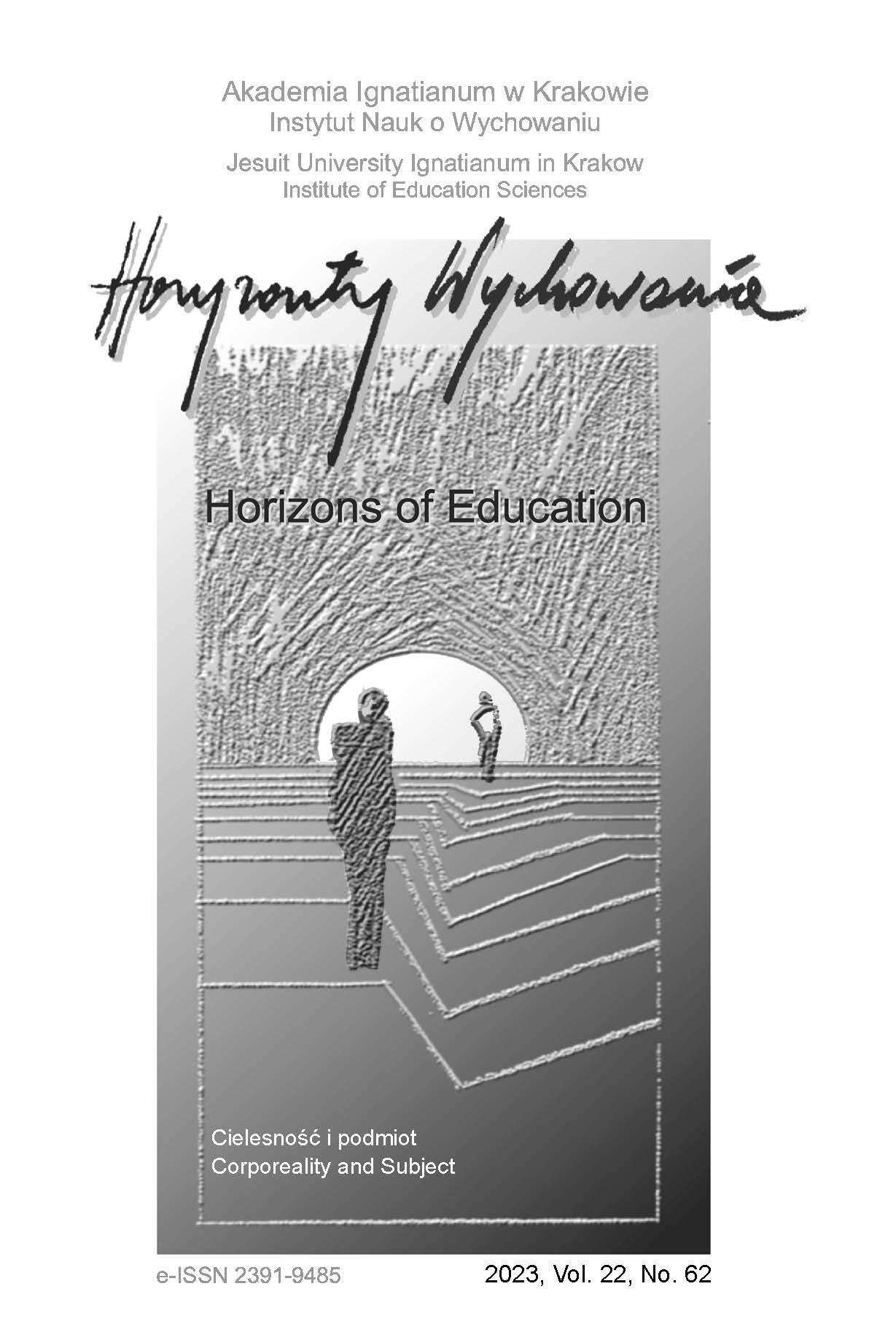Human Well-Being in the Context of Rapid Changes to the Sound Environment During the COVID-19 Pandemic
Abstract
RESEARCH OBJECTIVE: The aim of the article is to analyze the impact of the sound environment on human well-being during rapid changes to the audiosphere.
THE RESEARCH PROBLEM AND METHODS: What changes in the audiosphere took place during the lockdown? How were they perceived by the respondents, taking into account their well- being? The research material was free-form interviews focused on the problem, with elements of expert interviews conducted during the COVID-19 pandemic.
THE PROCESS OF ARGUMENTATION: The research analysis focused on the respondents’ perception of changes in the audiosphere during the lockdown and the impact of these changes on their well-being. Attention was paid to the similarities and differences in the perception of the sound environment and the reasons for these differences.
RESEARCH RESULTS: All interviewees reported changes in the sound environment during the pandemic and an impact on their well-being. The intensity of changes varied, depending on the place of residence and previous lifestyle. In addition to the negative changes, there were positive ones, such as less traffic noise, more sounds of nature, and new inspiring sound phenomena. The psychological (focusing on oneself and one’s body, encouragement to meditation) and artistic (artistic inspiration) potential of the new sound environment was noted.
CONCLUSIONS, INNOVATIONS, AND RECOMMENDATIONS: The reflective potential brought about by the changes to the audiosphere during the pandemic has not yet been used. Experiences from the pandemic can help care for the soundscape and plan possible modifications to it in order to improve people’s health and well-being. More research on functioning after returning to the previous sound environment is needed. If a similar situation is repeated, its educational and psychoeducational potential should be used.
References
Brooks, S.K., Webster, R.K., Smith, L.E., Woodland, L., Wessely, S., Greenberg, N. & Rubin, G.J. (2020). The psychological impact of quarantine and how to reduce it: Rapid review of the evidence. The Lancet, 395(10227), 912‑920. https://doi.org/10.1016/S0140‑6736(20)30460‑8
Chan, H.W., Ignacio, A., Rebello, C. & Cupchik, G. (2022). The therapeutic value of creative artmaking during the COVID-19 pandemic. Journal of Gifted Education and Creativity, 9(1), 93-113.
Diener, E., Lucas, R.E. & Oishi, S. (2004). Dobrostan psychiczny. Nauka o szczęściu i zadowoleniu z życia. W: J. Czapiński (Ed.), Psychologia pozytywna. Nauka o szczęściu, zdrowiu, sile i cnotach człowieka (pp. 35-49). Wydawnictwo Naukowe PWN.
Dinacci, L. (2021). New frontiers of corporeality. Inhabiting the world during pandemic, Italian Journal of Health Education, Sports and Inclusive Didactics, 5 (1). https://doi.org/10.32043/gsd.v5i1.315
Gibbs, G. (2011). Analiza danych jakościowych (M. Brzozowska-Brywczyńska, Trans.). Wydawnictwo Naukowe PWN.
Hasegawa, Y., & Lau, S. (2022). Aqualitative and quantitative synthesis of the impacts of COVID‑19 on soundscapes: A systematic review and meta-analysis. Science of the Total Environment, 844, 157223. http://dx.doi.org/10.1016/j.scitotenv.2022.157223
Jeziorański, M. (2022). Milcząca obecność ciszy w refleksji pedagogicznej. Ateneum Kapłańskie, 2(681), 262-273.
Kabzińska, I. (2017). Nadwrażliwi – kulturowi „odmieńcy”. Etnografia Polska, 61(1-2), 83-103.
Kvale, S. (2010). Prowadzenie wywiadów (A. Dziuban, Trans.). Wydawnictwo Naukowe PWN.
Merleau-Ponty, M. (1993). Fenomenologia percepcji. Fragmenty (J. Migasiński & P. Stefańczyk, Trans.). Instytut Filozofii i Socjologii PAN.
Misiak, T. (2010). Audiosfera w kulturze współczesnej. Próba przybliżenia pojęcia. Przegląd Kulturoznawczy, 1(7), 62-74.
Momro, J. (2020). Ucho nie ma powieki. Dźwiękowe sceny pierwotne. Wydawnictwo Uniwersytetu Jagiellońskiego.
Olearczyk, T. (2010). Pedagogia ciszy. Wydawnictwo WAM.
Oliveros, P. (2005). Deep listening: A composer’s sound practise. iUniverse.
Panda, P.K., Gupta, J., Chowdhury, S.R., Kumar, R., Meena, A.K., Madaan, P., Sharawat, I.K., & Gulati, S. (2021), Psychological and behavioral impact of lockdown and quarantine measures for COVID-19 pandemic on children, adolescents and caregivers: A systematic review and meta-analysis. Journal of Tropical Pediatrics, 67(1). https://doi.org/10.1093/tropej/fmaa122
Pikała, A., & Sasin, M. (2016). Arteterapia. Scenariusze zajęć. Wydawnictwo Uniwersytetu Łódzkiego.
Ryff, C.D. (1989). Happiness is everything or is it? Explorations on the meaning of psychological wellbeing. Journal of Personality and Social Psychology, 57(6), 1069-1081. http://dx.doi.org/10.1037/0022-3514.57.6.1069
Sa Carvalho, C. (2008). Ciało jako miejsce rozwoju. Horyzonty Wychowania, 7(14), 53-79. https://horyzontywychowania.ignatianum.edu.pl/HW/article/view/1051
Sasin, M. (2019). Ekologia akustyczna – nieobecny dyskurs w pedagogice. Teraźniejszość – Człowiek – Edukacja, 22(1), 31-48.
Sasin, M. (2022). Stosunek do doznań słuchowych człowieka a świadomość ciała i cielesności. Perspektywa ekologii akustycznej. Nauki o Wychowaniu. Studia Interdyscyplinarne, 14(1), 58-72.
Schafer, R.M. (1977). The soundscape: Our sonic environment and the tuning of the world. Destiny Books.
Shilling, C. (2021). Socjologia ciała (M. Skowrońska, Trans.). Wydawnictwo Naukowe PWN.
Skryplonek, Ł. (2011). Wywiad ekspercki w badaniach pedagogicznych. Rocznik Pedagogiczny, 34, 209-223.
Szpunar, M. (2020). Ekologia pejzażu dźwiękowego. Avant, 11(3). DOI:10.26913/avant.2020.03.33
Sztompka, P. (2005). Socjologia wizualna. Fotografia jako metoda badawcza. Wydawnictwo Naukowe PWN.
Trybalska, G., Namysłowski, G. & Morawski, K. (1997). Hałas i jego wpływ na organizm człowieka. Audiofonologia, 11, 295-301.
Twardowska-Staszek, E., Seredyńska, A., Rostek, I. & Biel, K. (2021). Nastrój i emocje Polaków podczas pandemii COVID-19. Horyzonty Wychowania, 20(55), 11-26. https://doi.org/10.35765/hw.2075
Zembylas, M. & Michaelides, P. (2004). The sound of silence in pedagogy. Educational Theory, 54(2), 193-210. https://doi.org/10.1111/j.0013-2004.2004.00005.x
Copyright (c) 2023 HORIZONS OF EDUCATION

This work is licensed under a Creative Commons Attribution-NoDerivatives 4.0 International License.
Authors who publish in this journal agree to the following terms:
- Authors retain the copyright to their work while granting the journal the right of first publication. The work will be simultaneously licensed under a CC BY-ND license, which permits others to share the work with proper credit given to the author and the original publication in this journal.
- Authors may enter into additional, non-exclusive agreements for the distribution of the published version of the work (e.g., posting it in an institutional repository or publishing it in another journal), provided that the original publication in this journal is acknowledged.
We allow and encourage authors to share their work online (e.g., in institutional repositories or on personal websites) both before and during the submission process, as this can foster beneficial exchanges and lead to earlier and increased citations of the published work. (See The Effect of Open Access). We recommend using any of the following academic networking platforms:





